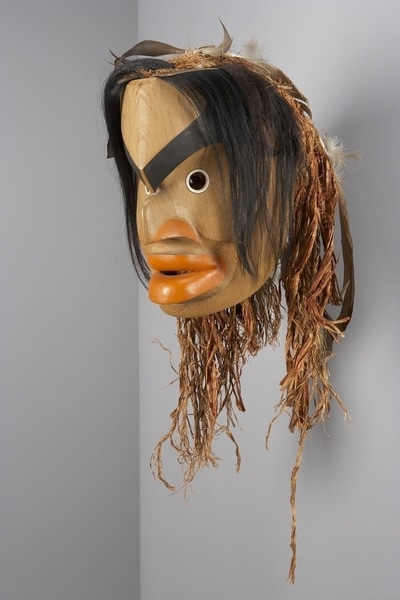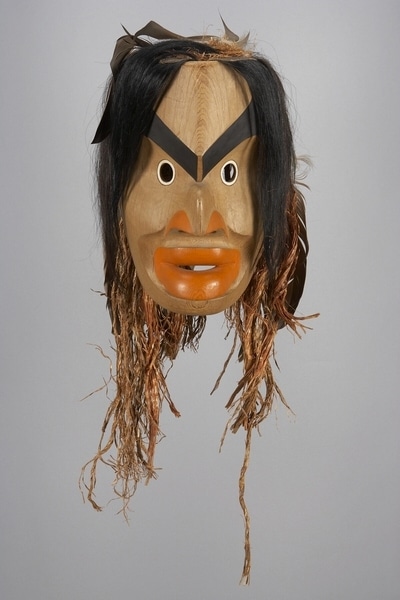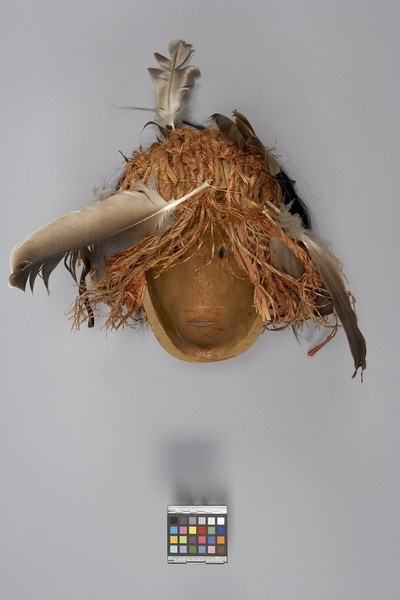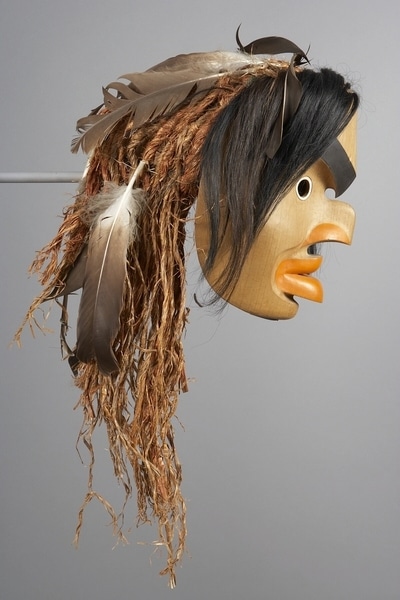Mask Item Number: Nb11.223 from the MOA: University of British Columbia




Description
The shape of the mask is like a high triangle, two planes intersecting on the median of the face. The heavy eyebrows are painted black, but are not raised. The brow slopes and projects sharply above the nose. Each eye is set in a concave orb in the mask. The eye is made up of a painted white ring surrounding a round hole (2 cm. in diameter, 2 mm deep). The hooked nose is long and narrow and merges with the backswept cheek planes. Up-thrusted narrow nostrils are painted orange. The mouth, encircled by a concave recess, is formed by full, protruding lips, drawn back slightly separated and painted orange. Along the top edge of the mask extend strands of black hair shredded and twisted cedar bark strands, and grey-white feathers. Inside the mask is a leather frame to fit the head.
History Of Use
This mask is called 'Wild Man of the Woods', 'Yellow Cedar Man' and 'Cockle Hunter'. The character was a non-human being living in the woods. He ate ghost food and tried to persuade humans to eat it also, so that they would stay in his unreal forest world. He attracted the spirits of the drowned to his invisible house. In Kwakwaka'wakw dances he is shown looking around shyly for cockle shells. Some cockle shells are planted for the dancer to find. The rights to use the Wild Man mask in potlatches are inherited and the dances are secret on the West Coast.
Cultural Context
ceremonial; potlatch
Narrative
The mask was worn byJoe David in a film by Nina Wisnicki in 1976. It was inspired by Willie Seaweed's style, as exemplified by the wild man mask in the Museum's collection (A6242). Joe David incorporated Willie Seaweed's style and the strong facial planes of the Nuu-chah-nulth style. The eyebrows and lips are carved and painted like Seaweed's, but the form of the nose is David's own interpretation.
Item History
- Made by Joe David (Maker) in Clayoquot, British Columbia, Canada during 1975
- Owned by Joe David before September 3, 1976
- Received from Joe David (Seller) and Museum of Anthropology Donations Fund (Funding source) on September 3, 1976
What
Who
- Culture
- Nuu-chah-nulth: Tla-o-qui-aht
- Creator
- Joe David (Maker)
- Previous Owner
- Joe David
- Received from
- Joe David (Seller) and Museum of Anthropology Donations Fund (Funding source)
Where
- Holding Institution
- MOA: University of British Columbia
- Made in
- Clayoquot, British Columbia, Canada
When
- Creation Date
- during 1975
- Ownership Date
- before September 3, 1976
- Acquisition Date
- on September 3, 1976
Other
- Condition
- good
- Accession Number
- 0329/0001